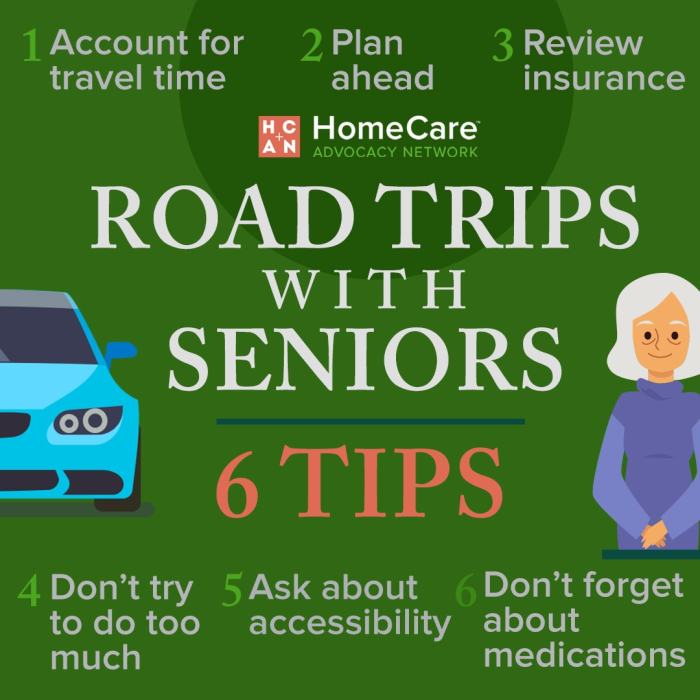Road Trips For Seniors: The open road beckons, promising adventure and rejuvenation, but planning a successful trip for older travelers requires careful consideration. This guide navigates the complexities of senior-friendly travel, from selecting the ideal destination and mode of transportation to ensuring safety and maximizing enjoyment along the way. We’ll delve into practical tips for budgeting, accommodation choices, and managing potential health concerns, transforming a potential challenge into a memorable experience.
This comprehensive resource provides detailed itineraries, safety checklists, and activity suggestions tailored to the needs and preferences of senior travelers. Whether you’re envisioning a scenic coastal drive or exploring America’s national parks, we’ll equip you with the knowledge and tools to plan a road trip that is both fulfilling and worry-free. We’ll cover everything from choosing the right vehicle and optimizing your route for comfort to capturing memories that will last a lifetime.
Choosing the Right Destination

Planning a road trip requires careful consideration, especially for senior travelers. Factors such as accessibility, comfort, and points of interest must be prioritized to ensure a safe and enjoyable experience. This section will Artikel key considerations for selecting the perfect destination, focusing on routes and amenities tailored to the needs of older adults.
Three Distinct Road Trip Routes Across the USA
Several routes cater specifically to senior travelers’ preferences for manageable distances, accessible attractions, and scenic beauty. The first option is a leisurely journey along the Blue Ridge Parkway, traversing Virginia and North Carolina. This route offers stunning mountain vistas, historical sites like the Mabry Mill, and numerous pull-offs with scenic overlooks, minimizing strenuous hikes. The parkway’s gentle gradients and well-maintained roads make it ideal for comfortable driving.A second appealing option is a coastal drive along the Pacific Coast Highway (Highway 1) in California.
This route boasts breathtaking ocean views, charming coastal towns like Carmel-by-the-Sea, and opportunities for whale watching (seasonal). While some sections might involve winding roads, the overall journey offers numerous stops with accessible amenities and opportunities for rest. Consider focusing on shorter segments to manage driving time effectively.Finally, a more centrally located option is a tour of national parks in the Southwest, focusing on easily accessible areas of places like Zion or Bryce Canyon National Park.
These parks offer stunning landscapes, but careful route planning is crucial. Prioritize parks with paved trails and accessible visitor centers. Research specific trail accessibility before embarking on any hikes, and remember that weather conditions can significantly impact comfort levels.
Coastal vs. Mountain Routes for Senior Travelers
Coastal routes often provide flatter terrain and generally easier driving conditions compared to mountain routes. Coastal towns typically offer a wider array of amenities and services, including accessible restaurants and accommodations. However, coastal areas can be more susceptible to unpredictable weather conditions.Mountain routes, while offering breathtaking scenery, present challenges such as winding roads, higher altitudes (potentially impacting breathing), and potentially less accessible amenities.
However, mountain towns often possess a slower pace of life, offering a more tranquil travel experience. The choice depends on individual preferences and physical capabilities.
Destinations with Senior-Specific Services and Amenities, Road Trips For Seniors
Several destinations are known for their robust infrastructure catering to senior travelers. The Villages in Florida, a sprawling retirement community, offers numerous amenities specifically designed for older adults, including accessible transportation, healthcare facilities, and a wide array of recreational activities. Similarly, many smaller towns in the Pacific Northwest, such as Leavenworth, Washington, or Astoria, Oregon, offer a slower pace of life and accessible accommodations, making them ideal for relaxed exploration.
Many coastal towns offer accessible beaches and boardwalks.
Factors to Consider When Choosing a Destination Based on Senior Mobility and Health Conditions
Before finalizing a road trip destination, carefully consider the following:
- Accessibility of attractions and accommodations: Look for places with wheelchair ramps, accessible restrooms, and elevators.
- Road conditions: Avoid routes with excessively steep grades or winding roads if mobility is a concern.
- Altitude: High altitudes can impact breathing, especially for those with respiratory conditions.
- Weather conditions: Check the forecast and plan accordingly to avoid extreme temperatures or inclement weather.
- Availability of medical services: Ensure access to healthcare facilities along the route and at the destination.
- Proximity to amenities: Choose destinations with readily available restaurants, pharmacies, and other essential services.
- Pace of travel: Plan for shorter driving days and ample time for rest and relaxation.
Transportation and Safety

Planning transportation and prioritizing safety are paramount for seniors embarking on road trips. The choice of mode of transportation significantly impacts both the enjoyment and the risk level of the journey. Careful consideration of individual capabilities and potential hazards is crucial for a successful and safe experience.
Choosing the Right Mode of Transportation
Seniors have several transportation options for road trips, each with its own set of advantages and disadvantages. Private vehicles offer flexibility and control, while RVs provide lodging and convenience. Tour buses, conversely, offer organized itineraries and reduced driving responsibilities.
- Private Car: Offers maximum flexibility and control over itinerary and stops. However, it requires the driver to be physically and mentally capable of handling long distances and potential driving challenges. Fatigue and health issues can pose significant risks.
- RV: Combines transportation and accommodation, eliminating the need for nightly hotel bookings. However, RVs require specialized driving skills and can be challenging to maneuver, particularly in congested areas. Maintenance and potential mechanical issues are additional considerations.
- Tour Bus: Provides a stress-free experience with a professional driver handling navigation and driving responsibilities. However, it limits flexibility in itinerary and may not cater to individual preferences or needs. Cost can also be a significant factor.
Driving Safety Precautions for Seniors
Long-distance driving presents unique challenges for seniors. Implementing proactive safety measures significantly reduces risks associated with fatigue, unexpected events, and changing road conditions.
- Regular Rest Stops: Plan frequent breaks every two hours to rest and stretch. This helps combat driver fatigue, a major contributor to accidents. Taking short walks during stops further enhances alertness and reduces stiffness.
- Emergency Preparedness: Keep an emergency kit in the vehicle, including a first-aid kit, jumper cables, flashlight, and a fully charged cell phone. Inform a trusted contact of the travel itinerary and expected arrival times.
- Defensive Driving Techniques: Seniors should practice defensive driving techniques, maintaining a safe following distance, being aware of blind spots, and anticipating the actions of other drivers. Regular eye exams and updated prescription glasses are crucial.
Adapting Vehicles for Senior Drivers
Modifying vehicles can significantly enhance comfort and safety for senior drivers. These adaptations cater to specific physical limitations and improve overall driving experience.
- Ergonomic Adjustments: Adjustable seats, steering wheels, and pedals allow for customized positioning, reducing strain and discomfort during long drives. Larger mirrors improve visibility.
- Adaptive Driving Aids: Features such as backup cameras, lane departure warnings, and blind-spot monitoring systems enhance situational awareness and reduce accident risks. These systems compensate for age-related vision or reaction time changes.
- Vehicle Modifications for Mobility: For seniors with mobility issues, modifications like hand controls or ramps can improve accessibility and ease of entry and exit.
Effective GPS and Navigation App Usage
GPS and navigation apps are invaluable tools for road trips, but their effective use requires understanding and preparedness.
- Pre-Trip Planning: Download maps and routes beforehand to avoid reliance on cellular data in areas with limited connectivity. Familiarize yourself with the app’s features and functions before departure.
- Dealing with Unexpected Issues: Know how to adjust routes in response to traffic delays, road closures, or unforeseen circumstances. Have backup navigation methods, such as paper maps, readily available.
- Regular Updates: Ensure that the navigation app is updated with the latest map data to avoid inaccurate information or outdated route suggestions.
Activities and Entertainment: Road Trips For Seniors
Planning engaging and appropriate activities is crucial for a successful senior road trip. The key is to balance stimulating sightseeing with ample opportunities for rest and relaxation, catering to diverse mobility levels. Over-scheduling can lead to fatigue and detract from the enjoyment of the journey.
Activity Selection for Varied Mobility Levels
Choosing activities that accommodate varying mobility levels ensures everyone enjoys the trip. Consider these options:
- Low-Mobility Activities: Scenic drives along picturesque routes, offering breathtaking views without requiring extensive walking. These could include routes through national parks with accessible viewpoints, or coastal drives with stunning ocean vistas. Many national parks offer accessible tram tours or shuttle services to key locations. For example, a drive along the Pacific Coast Highway in California provides spectacular views with minimal physical exertion.
- Moderate-Mobility Activities: Visits to historical sites with accessible entrances and well-maintained pathways. This could include museums with ramps and elevators, or historical towns with relatively flat terrain. For instance, exploring Colonial Williamsburg in Virginia offers a rich historical experience with options for accessible transportation within the site.
- High-Mobility Activities: Hiking on well-maintained trails with gentle inclines, or engaging in leisurely walks through charming towns or botanical gardens. Many national parks and state parks offer a variety of trails graded by difficulty, allowing for the selection of appropriate routes. A visit to a botanical garden, like the New York Botanical Garden, offers diverse walking paths and opportunities for exploration.
Daily Activity Planning: Balancing Sightseeing and Rest
A well-structured daily itinerary balances sightseeing with ample rest periods. This prevents overexertion and ensures everyone enjoys the experience. Consider incorporating short breaks throughout the day, scheduling longer rest periods in the afternoon, and allowing for flexibility to adjust the plan based on individual needs. For instance, a morning visit to a historical site could be followed by a leisurely lunch and an afternoon spent relaxing at a scenic viewpoint, before returning to the accommodation for an early evening.
Resources for Senior-Friendly Attractions
Several apps and resources provide valuable information on senior-friendly attractions and activities.
- Road Scholar: Offers a wide range of educational travel programs specifically designed for older adults.
- AARP: Provides travel resources and discounts for members, including information on accessible accommodations and attractions.
- Google Maps: Offers accessibility information for many locations, including details on ramps, elevators, and accessible restrooms.
Sample Day’s Itinerary: History, Scenery, and Relaxation
This itinerary incorporates historical sites, scenic viewpoints, and rest periods, catering to varying mobility levels.
- Morning (9:00 AM – 12:00 PM): Visit a historical site with accessible features (e.g., a museum with elevators and ramps). Allow for ample time to explore at a comfortable pace, incorporating breaks as needed.
- Lunch (12:00 PM – 1:00 PM): Enjoy a leisurely lunch at a restaurant with accessible seating. Consider a picnic lunch at a scenic location if preferred.
- Afternoon (1:00 PM – 4:00 PM): Travel to a scenic viewpoint with accessible parking and viewing areas. Spend time enjoying the views and relaxing. This could be followed by a brief, accessible walk on a nearby trail if desired.
- Late Afternoon/Evening (4:00 PM onwards): Return to accommodation for rest and relaxation. Enjoy a quiet evening, perhaps with a light dinner and some downtime.
Embarking on a road trip as a senior offers a unique opportunity for exploration, relaxation, and connection. By carefully considering the factors Artikeld in this guide – from meticulous planning and health preparedness to embracing the joy of the journey – you can transform your road trip into an unforgettable adventure. Remember to prioritize comfort, safety, and enjoyment, ensuring that the memories created far outweigh any logistical challenges.
The open road awaits; seize the moment and make it count.

